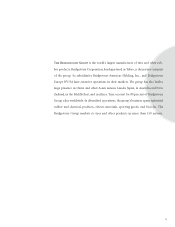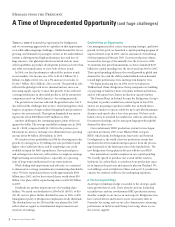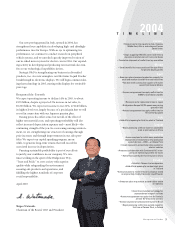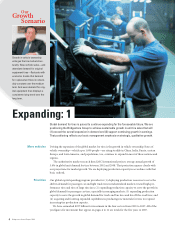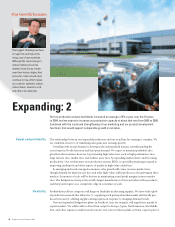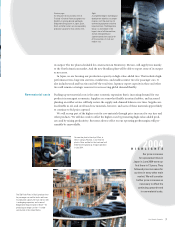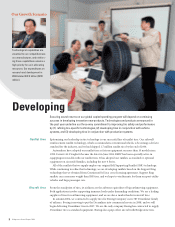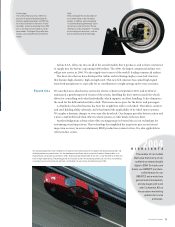Bridgestone 2004 Annual Report Download - page 13
Download and view the complete annual report
Please find page 13 of the 2004 Bridgestone annual report below. You can navigate through the pages in the report by either clicking on the pages listed below, or by using the keyword search tool below to find specific information within the annual report.
11
Our Growth Scenario
Proof in speed
in Shenyang, China, will begin producing steel cord in October 2005. Our steel cord plants are an
important source of that material for our tire manufacturing in every principal market.
Textile tire cord is also an important raw material in tire production. We produce textile materi-
als for tires at several sites around the world.
Success in motorsports illustrates the value of hands-on capabilities in developing and producing
raw materials. Our tires have reigned dominant for several years in Formula One (F1) racing, in the
IndyCar series, and in the Champ Car series.
Our work in F1 and other motorsports has benefited from repeated advances, including occasion-
al breakthroughs, in raw material technologies. The molecular structure of carbon black, for exam-
ple, is a decisive factor in the grip and wear of tread compound. Our Japanese subsidiary that
produces carbon black has contributed greatly to our racing program through advances in that raw
material.
A few years ago, our U.S. subsidiary captured attention with a breakthrough in racing perfor-
mance. At the heart of that breakthrough was a new polymer structure for the synthetic rubber used
in the tread compound. The company’s hands-on capabilities in developing and manufacturing
synthetic rubber enabled its racing engineers to secure the new polymer they required.
Previous page:
Our rubber estate in Kalimantan, Indonesia,
allows us to gain hands-on experience in
cultivating rubber trees and in processing
natural rubber. We recently agreed to pur-
chase a second rubber estate in Indonesia,
and a Bridgestone Group company operates
the world’s largest rubber estate, in Liberia.
Right:
Research work at our rubber estates promises
to help identify ways to increase yields in rub-
ber tree cultivation, to secure higher-quality
rubber, and to use rubber more effectively in
tires.
The rubber estate that we
recently agreed to purchase
on the Indonesian island of
Sumatra occupies some
18,000 hectares (47,000 acres)
and employs about 5,000
people. An on-site facility
processes natural rubber
produced at the estate and
elsewhere in the vicinity.
We will also conduct
R&D at the site.
2004
HIGHLIGHTS
Left:
The Bridgestone Americas Center for
Research and Technology, in Akron, Ohio,
is a world leader in polymer science. Among
the center’s numerous “firsts” are “synthetic
natural” polyisoprene rubber; process tech-
nology for acrylonitrile-butadiene-styrene
(ABS) high-impact plastics; and head-tail
functionalized elastomers from heteroatomic
initiators that reduce wear and improve fuel
economy in tires.
Our new carbon black plant in
Thailand’s Rayong Province (right)
provides high-quality supplies of that
raw material to Bridgestone tire
plants in Asia. Another Bridgestone
plant in Thailand (above) provides our
tire plants in Asia with high-quality
steel cord.


